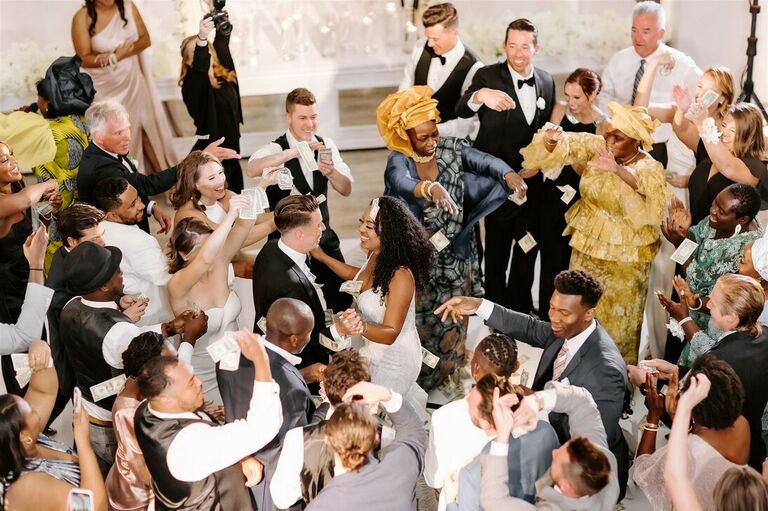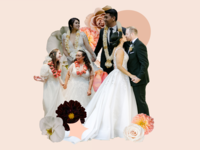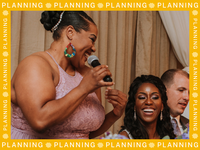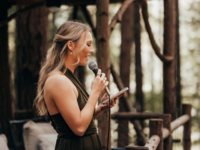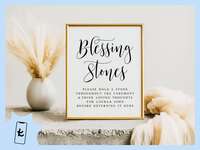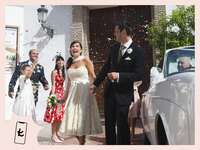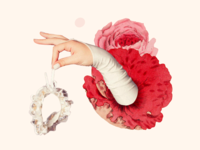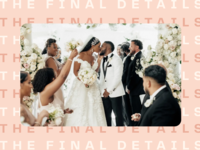The Complete Guide to Congolese Wedding Traditions
The Democratic Republic of the Congo is the second-largest country in Africa, home to over 100 million people, 200 ethnic groups (including Bantu, Mongo and Luba), and nearly 250 languages. It is also home to some of the most stunning natural scenery and wildlife in the entire world; as one of the 17 mega-diverse nations worldwide, Congo is home to vast rainforests, scenic national parks and the only wild bonobo population in the world.
With so much variation in culture, Congolese weddings are a unique blend of traditional, colonial and Western customs. But one thing is for sure: expect a ton of dancing. "Congolese weddings are known for two things: music and attire," says Laetitia Gnoumou, founder and lead planner of A Peace of Cake, an event planning service based in Boston. Gnoumou is of Congolese descent and specializes in planning weddings, with a big focus on ethnic African weddings and events.
According to Gnoumou, Congolese weddings are quite patriarchal and include much scrupulous attention to detail. "There is a big element of respecting your elders, sitting in the right place at the right time, and overall, adhering to the rules," she says. But don't worry too much—we'll discuss some of those rules in the rest of this article. And despite the emphasis placed on adhering to tradition, there is still room for tons of fun at a Congolese wedding. "If I had to summarize Congolese weddings in three words, I'd say they're fun, active and eclectic," says Gnoumou.
Read on to learn more about Congolese wedding traditions, and start planning your own special day full of cultural customs and rituals.
A Brief History of Congolese Wedding Traditions
Like many countries in Africa, the land now known as the Democratic Republic of Congo (DRC), and the smaller Republic of Congo located to its northwest, have been forever changed by a tragic history of enslavement and colonization. Today, Congolese people incorporate long-held traditional customs from indigenous ethnic tribes along with more recent colonial customs influenced by French and Belgian rule. In the last few generations (since the 1990s or so), the Western "white wedding" has become increasingly popular, with many Congolese and Congolese-American weddings looking like those in the United States. This blend of traditions means Congolese weddings may incorporate French or Kituba with Lingala, Swahili or other regional languages.
Congolese Pre-Wedding Traditions
The Knocking, or Presentation
The engagement process for a Congolese wedding is fun and filled with family. Traditionally, the groom would go to the bride's family and ask for her parents' permission to marry their daughter. He will also bring a bride price to the bride's family. These items differ depending on which tribe the bride comes from, but would often include goats, chickens or other livestock, home furnishings like pots, lanterns or knives, or luxury items. Today, cash is typically used instead of those items, with a corresponding value attached.
Congolese Wedding Ceremony Traditions
These days, Congolese wedding ceremonies will follow the traditional tribal customs, the Western white wedding, or a combination of both. No matter which route the couple chooses, there will typically be a lot of involvement from family members on both sides.
"One of the biggest hurdles is trying to please both the bride and both sets of parents," says Gnoumou. According to her, Congolese weddings can take a patriarchal element, so a big part of the wedding ceremony involves respecting the elders and following the proper etiquette. If you aren't sure, just ask!
The Dot (Traditional African Ceremony)
The dot (pronounced "dote") is the traditional wedding ceremony that takes place not just in Congo, but in several other African countries as well. The dot traditionally takes place at the bride's parents' house. Friends and guests from each side of the family will be seated as the bride and groom and their families make statements and exchange dowries.
The Representative
On the wedding day, the groom will come to the bride's parents' house with an entourage that includes his parents and relatives, as well as a representative. The bride's family will also have their own representative. Each representative speaks on behalf of the families, introduces the guests who are present, and essentially serves as an MC for the ceremony. The representative is typically a close family friend.
Hiding the Bride
When the groom arrives at the bride's home, she will typically be hidden from sight. As the groom and his family and representative ask for the bride to come join them, there will typically be a series of pranks and tricks, where the bride's side will ask for more money or send down decoys, like her sister, in exchange for her. Eventually, the bride will join the party, and that will be time for the ceremony to commence.
Exchanging Gifts
The groom and his entourage will bring the gifts that were agreed upon at the engagement, most often in current days, cash. Once the bride has entered the party, the families will go through the gifts and confirm they are correct. Finally, the bride will give the envelope of money to her father as a symbol of acceptance. It is at this point that the couple is considered married, and much clapping and cheering will ensure.



The Western Wedding Ceremony
Toward the end of the 20th century, the Western ceremony, or "white wedding," became more widespread as Congolese people adopted Christian religions. Nowadays, a large percentage of Congolese weddings are Christian ceremonies led by a pastor in a venue.
These ceremonies tend to last an hour, although they've been getting shorter in recent times. The procession will include the groom escorted by his mother, then the bridesmaids and finally, the bride. Like at any joyous Congolese event, there is a lot of shouting and cheering. So much so, that most wedding processional music will not be heard. Gnoumou says this is a special kind of cheer, called milolo.
The ceremony itself will look a lot like weddings in the United States, following a Christian or secular program. Upon exit, expect a lot of dancing. The bridal party is expected to dance down the aisle as they exit to the reception.
Congolese Post-Ceremony and Reception Traditions
Speeches
Speeches are a big part of any Congolese wedding. Expect to hear speeches from the couples' parents, their family representatives, the maid of honor, best man and other wedding party. According to Gnoumou, the bride's father speaking is "a must."
Dancing
Another essential part of a Congolese wedding is dancing—not just during the reception, but throughout the entire day. "It's not a Congolese party if you don't give enough time for dancing," says Gnoumou. "If you've given less than a good three hours, you've failed."
This includes free dancing and choreographed moves. Many of the songs played at a Congolese wedding inherently come with their own choreography. In addition, the wedding party and other key guests will often choose to create their own choreographed dances that they perform.
Congolese Wedding Attire
Attire is a big deal at Congolese weddings—for both the couple and guests. Formal Congolese attire is often extremely ornate or flashy. Gnoumou says guests at Congolese weddings tend to dress much more formally than at other weddings. The couple, their parents, wedding party and guests alike will often wear different outfits throughout the night. "People change into flashier outfits for the reception," says Gnoumou. "There is a big element of showing off a little at a wedding."
Liputa
Liputa is a modern style of female fashion that consists of 100% cotton dyed with vibrant colors. It is traditionally worn to weddings and other special occasions. Liputa attire consists of four pieces of cloth made from the same material: a blouse, wrapper, belted bow and headscarf. Many Congolese brides will wear the liputa during the traditional wedding ceremony and reception.
The Bride, Groom and Bridal Party's Attire
These days, many Congolese brides will opt for a white wedding dress, at least for the ceremony portion if they are having a Western wedding. However, couples wanting to go to the traditional Congolese route will opt to use matching patterns for the bride's liputa and the groom's clothing.
The mothers of both the bride and groom are held in high honor at Congolese weddings, so a lot of emphasis is placed on multiple elaborate outfits they wear throughout the evening. The bride's close female friends and relatives will often wear matching liputa to differentiate themselves from the rest of the guests.
Congolese Traditional Wedding Food, Drinks and Desserts
A traditional Congolese wedding feast will include meat, fish, rice, fried plantains and potatoes. One delicacy likely to be served at a Congolese wedding is pondu, which is derived from the leaves of the cassava plant and prepared in a fragrant mix of garlic, onion and peppers.
Frequently Asked Questions About Congolese Wedding Traditions
What is the typical guest count at a Congolese wedding?
Congolese weddings tend to have larger guest counts than those in the States, with guest lists of over 200 people being very common. More and more couples are opting to hold the ceremony and reception in the same space, so larger venues are becoming more popular.
What types of gifts are customary at a Congolese wedding?
Like many Western weddings, gifts at a Congolese wedding will include a mix of mostly cards with cash inside, with some guests gifting actual physical objects. A unique gifting tradition happens at the bridal shower, where married guests will focus on giving the bride advice, rather than material objects. Of course, many still give home goods, and the bride's friends will often give lingerie.
Where can I see some examples of Congolese weddings?
Check out YouTube for full videos of Congolese wedding dances, including entrances and choreographed dances. This will give you a good idea of what to expect on the big day.
